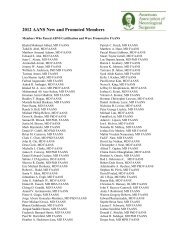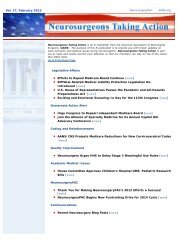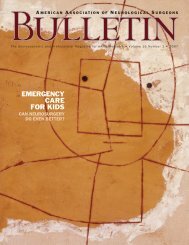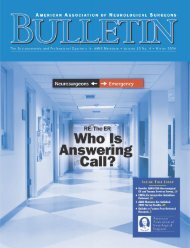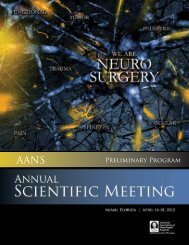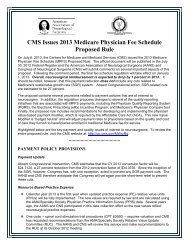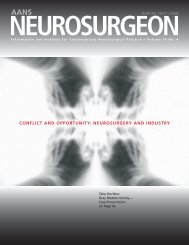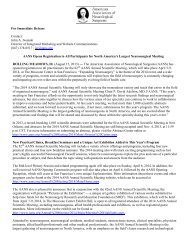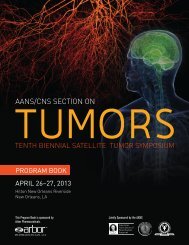view PDF - American Association of Neurological Surgeons
view PDF - American Association of Neurological Surgeons
view PDF - American Association of Neurological Surgeons
Create successful ePaper yourself
Turn your PDF publications into a flip-book with our unique Google optimized e-Paper software.
R ISKM ANAGEMENT M ICHAEL A. CHABRAJA, J D, AND M ONICA W EHBY, M D<br />
Surgeon’s Error or Jury’s Sympathy<br />
Patient Delays Surgery With Adverse Results<br />
When treating high-risk patients,<br />
the uncomfortable reality is that<br />
regardless <strong>of</strong> whether error is<br />
involved, juries <strong>of</strong>ten are swayed<br />
by severe outcomes.<br />
In this case, the defendant neurosurgeon<br />
had recommended surgery in June<br />
1994. Despite having received this recommendation,<br />
the patient elected to postpone<br />
the surgery until after his son’s<br />
wedding in October. The patient’s condition<br />
deteriorated rapidly after the wedding<br />
and somatosensory evoked potential<br />
monitoring performed prior to surgery<br />
failed to pick up any signals from his legs.<br />
The defendant neurosurgeon performed<br />
anterior cervical discectomy and fusion at<br />
C5–6 and C6–7 on the 57-year-old patient<br />
in October 1994 to remove two herniated<br />
discs and treat spinal stenosis caused by<br />
degenerative disc disease. Following surgery,<br />
the patient was paralyzed from the chest<br />
down. He remained a paraplegic with weakness<br />
<strong>of</strong> his arms and hands until he died<br />
from unrelated cancer approximately eight<br />
years later.<br />
The patient’s estate and his spouse sued<br />
the neurosurgeon and the hospital for malpractice.<br />
In addition to recovery <strong>of</strong> medical<br />
expenses, the estate sought damages for loss<br />
<strong>of</strong> normal life, pain and suffering and disfigurement.<br />
The spouse sought damages<br />
for loss <strong>of</strong> consortium and loss <strong>of</strong> services.<br />
The patient’s expert opined at trial that<br />
the postoperative films showed a disc fragment<br />
remaining in the spinal canal and<br />
pressing on the spinal cord, causing worse<br />
compression than the preoperative magnetic<br />
resonance images had revealed. The<br />
defense countered that the postoperative<br />
MR images showed that the spinal canal had<br />
been decompressed successfully. The<br />
defense further maintained that the patient’s<br />
spinal cord was so severely compromised<br />
prior to surgery that the cord could not<br />
withstand the normal trauma <strong>of</strong> surgery<br />
and the simple act <strong>of</strong> decompressing the<br />
stenotic spinal cord caused a spinal stroke.<br />
The evidence presented at trial demonstrated<br />
that in the weeks immediately preceding<br />
the surgery, the patient became<br />
numb from the waist down and had to use<br />
a wheelchair to get around. With regard to<br />
the issue <strong>of</strong> when the surgery took place,<br />
the defense introduced the neurosurgeon’s<br />
notes in the medical record documenting<br />
his discussion with the patient concerning<br />
the risks associated with delaying surgery.<br />
After deliberating for two days and<br />
twice reporting that it was deadlocked, the<br />
jury returned a verdict against the defendant<br />
neurosurgeon and in favor <strong>of</strong> the<br />
patient’s estate and his spouse in the<br />
amount <strong>of</strong> $2,269,034. The bulk <strong>of</strong> this<br />
sum, 1.5 million, was awarded to the estate<br />
and apportioned as $750,000 for loss <strong>of</strong><br />
normal life, $500,000 for pain and suffering,<br />
and $250,000 for disfigurement. The<br />
remainder <strong>of</strong> $769,034 was awarded to the<br />
patient’s spouse, with $517,034 allotted for<br />
medical expenses, $150,000 for loss <strong>of</strong> consortium<br />
and $102,000 for loss <strong>of</strong> services.<br />
Notably, the defendant hospital had settled<br />
out prior to trial for $400,000.<br />
Outcome’s Severity<br />
The fact that the jury twice reported that it<br />
was deadlocked is evidence <strong>of</strong> its struggle to<br />
reach a decision on liability. Although the<br />
patient’s decision to delay his surgery may<br />
well have resulted in further compromising<br />
his spinal cord, the jury ultimately concluded<br />
that this was insufficient to relieve<br />
the defendant neurosurgeon <strong>of</strong> liability.<br />
An argument can be made that the<br />
defendant neurosurgeon should have documented<br />
more clearly in his notes that he had<br />
explained the risks <strong>of</strong> paralysis as well as the<br />
risk <strong>of</strong> delaying surgery with the patient.<br />
However, it is far from clear that this action<br />
would have been outcome determinative.<br />
The result in this case illustrates that the<br />
risk <strong>of</strong> an adverse verdict is sometimes<br />
directly related to the severity <strong>of</strong> the outcome<br />
rather than to the actions taken by a<br />
surgeon. A 2002 study conducted by<br />
Kessler and McClellan underscores this<br />
conclusion and demonstrates its frequency.<br />
The study revealed that evidence <strong>of</strong> medical<br />
negligence was found in less than 20<br />
percent <strong>of</strong> cases in which a patient received<br />
some form <strong>of</strong> compensation from a medical<br />
provider and further that only one in<br />
every 15 patients who were found to have<br />
sustained an injury due to medical negligence<br />
received any sort <strong>of</strong> compensation.<br />
This evident lack <strong>of</strong> relationship<br />
between medical liability award and medical<br />
negligence compounds the risk <strong>of</strong> liability<br />
for specialists treating high-risk<br />
patients. Data maintained by medical liability<br />
insurance provider The Doctors<br />
Company shows that neurosurgeons frequently<br />
sustain claims, averaging a claim<br />
every 18 months. Thus, high-risk specialists<br />
such as neurosurgeons are sued more <strong>of</strong>ten,<br />
not because <strong>of</strong> medical negligence, but<br />
because <strong>of</strong> the risk <strong>of</strong> the medical condition<br />
and the severity <strong>of</strong> the adverse outcome. 3<br />
Michael A. Chabraja, JD, is a partner with<br />
McGuireWoods LLP in Chicago, Ill. Monica Wehby,<br />
MD, is a neurosurgeon with Microneurosurgical<br />
Consultants P.C. in Portland, Ore.<br />
Suggestions By exploring closed<br />
medical liability cases, Risk Management<br />
aims to help neurosurgeons identify<br />
and avoid areas <strong>of</strong> legal peril. If you<br />
would like to see a particular topic<br />
covered, please send your idea to<br />
Monica Wehby, MD, Risk Management<br />
editor, mcwehby@yahoo.com.<br />
Volume 14, Number 4 • AANS Bulletin 39



